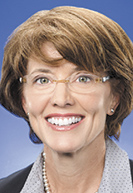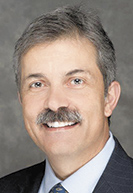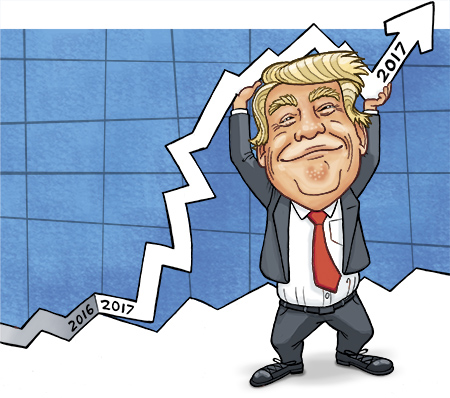Subscriber Benefit
As a subscriber you can listen to articles at work, in the car, or while you work out. Subscribe NowThe year 2016 took many investors on a roller-coaster ride. It started off with equity markets taking a steep dive before regaining ground and finally soaring after the election of Donald Trump as president.
Bond yields inched lower—with the yield on a 10-year Treasury reaching a record low in July—but swiftly reversed course after Nov. 8 amid a global sell-off.
While the Federal Reserve hardly surprised markets, the Brexit vote in the U.K. did, and investors are bracing for whatever curve balls 2017 might throw. With a new U.S. president, an upbeat growth outlook, and shifting geopolitical winds, six local money managers spell out what they’re looking for in 2017.
—Jared Council
Market momentum should pour into 2017
 Clark
ClarkBy Joseph A. Clark, CFP, RFC
The Financial Enhancement Group LLC, managing partner
One doesn’t have to think long to describe the biggest surprise of 2016. Trump’s victory startled those “in the know,” but the recent runup of the market caught Trump fans and foes equally off-guard. Stock indexes are at all-time highs and appear headed for more in 2017. Investors that had been buying into certain sectors quickly switched to others, rotating from utilities, for instance, into financials and industrials.
The biggest rotation, however, was from large-cap stocks into small-cap stocks and out of bonds. The S&P 500 and The Dow are both up, but nothing like the Russell 2000. That trend should continue into 2017 with Trump’s promise of less regulation, lower corporate tax rates and a stronger dollar. Each of those conditions favors smaller companies over their large counterparts.
The election also took the global bond market by surprise, sending it to its largest monthly loss in history. November saw $1.7 trillion in bonds go up in smoke. The Federal Reserve will indeed raise short-term rates, but its rhetoric will be most important in navigating the markets next year. We expect financials and industrials to continue to do well in 2017 and expect longer-term bond yields to moderate. We will be watching the credit spreads between Treasury bonds and high-yield bonds for a clue into economic strength. From an equity perspective, breadth will continue to be the guide for market stamina and potential. So far, both of those indicators recommend a portfolio poised for growth.
There is no force on the planet stronger than momentum, whether that be positive or negative. For now, the market has a positive momentum that we haven’t seen since March 2009.
Markets will be focused on fiscal policy
 Givens
GivensBy Nadine Givens
PNC Wealth Management of Central Indiana, director
As we ring in the new year and enter our eighth year of economic expansion, we anticipate an increase in economic growth from 1.5 percent to 2.2 percent for 2017. The effect of the political climate and decision-making in Washington will certainly bring with it shifts in economic conditions. We believe there might be some upside to our estimates based on a better business and tax environment going forward. As for investors, the timing of Fed rate hikes, bond yields given inflation expectations, geopolitics, and the increased trend of populism and oil prices will be key influencers to watch.
The market will be focused on how the government will contribute to the economy via infrastructure spending and tax reform. If the tax reform recommendations put forth by the House of Representatives and those of Donald Trump are adopted and implemented by Congress, the proposals will represent the most significant overhaul to the Tax Code since 1986. But keep in mind, even if those plans are enacted next year, funds will not enter the economy until 2018.
Strategies that help protect against the risk of rising rates will become increasingly important. While we do not believe interest rates will necessarily move markedly higher soon, rate volatility has certainly increased. The current federal funds rate (a signpost for analysts of where the economy stands) implies the economy is still in its earlier phases of recovery. We will likely see global nominal growth of 5 percent to 7 percent and mid-single-digits earnings growth for the S&P, assuming a yield of about 2.1 percent this year.
The S&P 500 could earn $130 per share (instead of our conservative $125 per share) and multiples remain near 20 times earnings.
If that happens, the market returns could hit the low teens.
Given the unknowns of how the United States will handle upcoming monetary and fiscal-policy decisions, we are especially focused on monitoring our fixed-income portfolios. We believe allocations to strategies outside the traditional fixed-income bond sector are prudent.
And while it’s tempting to inquire and predict the short-term behavior of the markets, our advice to investors is to continue to focus on their long-term goals.
Earnings drive equities
 Foster
FosterBy Mark Foster, CFA
Kirr Marbach & Co. LLC, chief investment officer
Investors spend countless hours gleaning data to develop their outlook. For us, it’s more simplistic. We believe stock prices follow earnings, with close to a 90 percent correlation. If earnings go up, stock prices will rise.
While other factors affect stock prices, earnings drive the bus. For most companies, earnings were essentially flat from 2014 to 2016, so most stocks went nowhere for that period—until recently.
Going forward, the picture is a little brighter. Several headwinds (stronger U.S. dollar and sharply declining energy profits) are abating and other positives are entering the picture (possible lower corporate tax rates, repatriation of cash and a less burdensome regulatory environment). To the extent these factors enhance the profit outlook, stocks should rise. Consensus estimates currently have earnings growing in the fourth quarter of 2016 (after eight quarters of flat comparisons) and into 2017.
While stock valuations are not as cheap as they were several thousand Dow Jones industrial average points ago, we don’t think they are overly expensive, either. Interest rates have risen and the Federal Reserve recently took another step toward normalizing rates. We are years removed from the crisis of 2008, so this move was overdue.
Since the crisis, investors have abandoned stocks and fled to bonds, seeking income and “safety” from the volatility of equity markets. Bond funds have had inflows in seven of the past eight years. Additionally, the past three years have seen over $1.3 trillion move to passive index funds and ETFs—much of this coming from active managers, who suffered $750 billion in outflows.
On Oct. 17, The Wall Street Journal published “The Dying Business of Picking Stocks,” which argued that attempts by active managers to outperform the benchmarks by picking individual stocks were futile; the story declared passive index investing the winner. This headline could be the distant cousin to the infamous BusinessWeek cover of Aug. 13, 1979, which declared “The Death of Equities.” As contrarians, we love to see headlines like these, as they typically appear at or near inflection points.
In 2017, we think active management will reassert itself, as it has since the October WSJ article. In addition, the rise in rates has led to losses for investors who piled into bond funds. If these flows reverse, the stock market could get very interesting. As Mark Twain said, “History doesn’t repeat itself, but it does rhyme.”
Watch for lower tax rates, higher interest rates
 Farra
FarraBy George S. Farra, CFA
Woodley Farra Manion Portfolio Management, co-founder, principal
Investors welcomed the New Year with the major U.S. indexes at record levels, an unexpected event after a year of many unexpected events (e.g., Brexit, Chicago Cubs, Trump). The broader-based S&P 500 Index recorded its sixth-best year of the millennium, amid optimism the malaise that has been the norm for most of this period might be ending.
Few investors have a crystal ball that can foresee how 2017 will evolve, so making a big call and positioning your investment portfolio accordingly is typically a fool’s errand. The year 2016 certainly proved this point. But we can make a stab at what might be trends or events that will shape the trajectory of the stock market.
Positives:
■ Lower corporate tax rates will boost earnings, support higher stock valuations.
■ Lighter regulation increases flexibility and reduces compliance costs.
■ Lower personal tax rates will boost spending and savings.
■ Higher budget deficit will stimulate growth.
■ Expanded energy production will keep a lid on energy costs, boost capital spending.
■ Foreign earnings repatriation will spur greater corporate spending (investment, dividends, share buybacks, M&A).
Negatives:
■ The Fed has already responded to the potential for faster growth and inflation by increasing its projected number of interest-rate hikes in 2017 from two to three.
■ Higher interest rates could crimp expected profit growth, slow housing and capital expenditures.
■ Tighter credit conditions might lower auto sales, cutting employment in the sector.
■ Threats of protectionism could alter trade relationships and investment in U.S. operations.
■ Higher inflation could prompt the Fed to increase short-term interest rates (the Federal Funds rate) faster and higher than expected.
■ LIBOR rates (short-term borrowing rates between banks and the benchmark for many corporate loans) have already increased from 0.50 percent at the end of 2015 to nearly 1 percent.
■ Interest costs for the federal debt will increase, potentially forcing Congress to reduce projected levels of tax cuts and spending.
We will know by the end of 2017 if this year does, indeed, mark a turning point in the economy and I hope we will have fun doing so!
Volatility poised to be key theme
 Reed
ReedBy Leslie D. Reed
RIM Group, managing partner
The year 2017, like every year, will present investment and financial challenges and opportunities. The market has already signaled that the current bull run will continue, albeit with increased volatility.
The new administration in Washington will certainly be where investors’ eyes should be focused as decisions about infrastructure spending, tax and fiscal policy will be front and center. I believe the first 90 days of the Trump era will set the tone for the near future. His transition rhetoric suggests he will take swift action as relates to the economy and job creation. If the Trump administration can deliver a job stimulus plan that is substantive, the markets will respond robustly. The recent rise in the market indexes is signaling that the markets believe this will be the case.
I am advising my clients to be ready for the increased volatility by having more of their investable funds in a cash position as the market sorts itself out. There will be turbulence but there will be opportunity. As far as asset classes, obviously, companies that are positioned to take advantage of infrastructure legislation that is stimulating to the economy will perform well. Given the uncertainty of the continuance of the Affordable Care Act, there will be increased activity in the health care sector as well. I continue to like some of the groups that will benefit from privatization.
I predict that, while the new administration and the resulting policy changes that might occur will be tenuous at times, the broader economy still has room to grow as neither the consumer nor the housing sector has fully participated in this bull run—and because of this there is still room for further growth in the equity markets. Bond prices will be under pressure as interest rates (Fed policy) should go higher. A slower approach to bond investing is in order. Finally, geopolitical concerns will grow and, with them, the true test of the new administration. This concern is not new, but certainly will be pervasive in 2017.
Trump ushers in new era, but Fed looms large
 Hahn
HahnBy Gregory J. Hahn, CFA
Winthrop Capital Management, chief investment officer
Capitalism and democracy work together to power economic growth and sustain our standard of living, and capitalism—with all its faults—is still the best generator of investment and human capital in the world. Years from now, when we look back on 2017, we expect to find that Donald Trump’s presidential election underscored a profound shift in the political ideology of our time, which in turn affected our economy, capital markets and the world.
We expect the key drivers to economic growth and price movements in financial assets for 2017 will be regulatory and tax reform, fiscal stimulus and a marginal shift in monetary policy toward higher interest rates. The domestic economy still shows imbalances and is supported by an aggressive asset purchase program that has kept interest rates near historic low levels, stifling capital investment and hurting savers. Banks play an important role in our financial system as the primary facilitators of extending credit. Motivating banks to extend credit to small business is critical to sustained economic growth. By lowering the risk for entrepreneurs to start businesses, we will spur business growth, create jobs, and broaden the tax base.
The larger risks to domestic growth are from global forces, including the growing populism in Europe and the credit bubble in China. While their direct impact on the U.S. economy might not be readily apparent, to the extent that capital flows are affected, it will effectively stifle risk taking and capital investment.
Investing is about managing risk, not just taking risk. With the Federal Reserve buying bonds in the open market, it is effectively manipulating and distorting the price of risk for investors. Since the economic recovery is still unbalanced, we believe there is a natural ceiling to how high interest rates will move next year. Any movement to lower taxes—both corporate and individual—will push municipal bond yields higher as banks and other investors reduce their holdings. This could create a wonderful buying opportunity for investors.
By some measures, equity valuations appear overvalued heading into the earnings season next month. We favor domestic stocks over developed and emerging-markets stocks next year. Small-cap stocks will likely outperform large-cap stocks. With higher interest rates and the potential for thoughtful regulatory reform, we favor an overweight to financial and health care stocks. Additionally, the repatriation of large cash balances will create opportunities for some global companies for capital investment and share repurchases.•
Please enable JavaScript to view this content.

